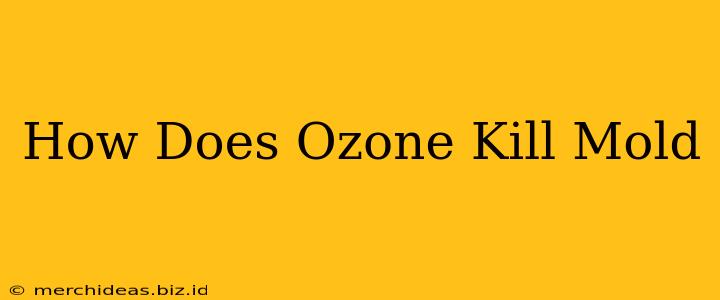Mold infestations are a serious problem, impacting indoor air quality and potentially causing health issues. While various methods exist for mold removal, ozone treatment has emerged as a powerful and effective technique. But how does ozone actually kill mold? Let's delve into the science behind this increasingly popular remediation method.
Understanding Ozone and its Oxidizing Power
Ozone (O3) is a highly reactive form of oxygen. Unlike the oxygen we breathe (O2), ozone contains three oxygen atoms. This extra oxygen atom makes it a potent oxidizing agent. Oxidation is a chemical process where electrons are transferred from one substance to another. In the context of mold remediation, ozone's powerful oxidizing properties are key to its effectiveness.
The Chemical Reaction: How Ozone Attacks Mold
When ozone comes into contact with mold spores, hyphae (the thread-like filaments of mold), and other organic matter, it readily reacts. The extra oxygen atom in the ozone molecule is easily transferred to the mold's cellular structures. This process disrupts the mold's cellular membranes and vital proteins, effectively destroying its ability to function and reproduce. The oxidation process essentially breaks down the mold's complex organic compounds, rendering it harmless.
Ozone's Advantages in Mold Remediation
Ozone offers several advantages over traditional mold removal methods:
- Effective Spore Elimination: Ozone is highly effective at eliminating mold spores, which are often responsible for re-infestation. Traditional methods may not always completely eradicate spores.
- Deep Penetration: Ozone can penetrate porous materials like drywall and wood, reaching mold colonies that are hidden from sight and inaccessible to other cleaning methods.
- Reduced Chemical Use: Ozone is a naturally occurring substance and doesn't leave behind harmful chemical residues, making it a more environmentally friendly option.
- Odor Elimination: In addition to killing mold, ozone also effectively neutralizes the musty odors often associated with mold infestations.
Limitations and Safety Precautions
While ozone is effective, it's crucial to understand its limitations and safety aspects:
- Safety Concerns: Ozone is a respiratory irritant and exposure to high concentrations can be harmful. Professional ozone treatment should always be conducted by trained technicians who utilize proper safety equipment and ventilation procedures. Never attempt ozone treatment yourself without professional guidance.
- Material Compatibility: Ozone can damage certain materials, such as some rubber and plastics. A professional assessment is crucial to determine if ozone treatment is suitable for your specific situation.
- Not a Replacement for Proper Cleaning: Ozone treatment is most effective when combined with thorough cleaning and moisture control to prevent future mold growth. It's not a standalone solution.
Choosing a Professional for Ozone Mold Remediation
When considering ozone treatment for mold remediation, it's vital to choose a reputable and experienced professional. Look for technicians who:
- Are properly certified and insured.
- Have a proven track record of success.
- Utilize advanced ozone generators and safety protocols.
- Provide a comprehensive assessment and post-treatment testing.
Finding a qualified professional ensures the safety and effectiveness of the treatment, maximizing the benefits of ozone's mold-killing capabilities.
Conclusion: Ozone – A Powerful Tool in the Fight Against Mold
Ozone offers a powerful and effective method for mold remediation. Its strong oxidizing properties allow it to eliminate mold spores, penetrate porous materials, and neutralize odors. However, safe and effective ozone treatment requires professional expertise. By understanding the science behind ozone's effectiveness and choosing a qualified professional, you can leverage this powerful tool to combat mold infestations and create a healthier indoor environment. Remember, always prioritize safety and consult with professionals to ensure proper application and mitigate potential risks.
